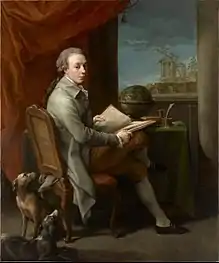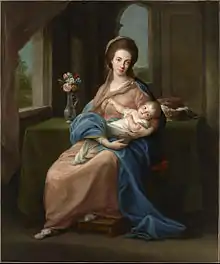Thomas Taylour, 1st Marquess of Headfort
Thomas Taylour, 1st Marquess of Headfort KP (18 November 1757 – 24 October 1829), styled Viscount Headford from 1766 to 1795, and known as The Earl of Bective from 1795 to 1800, was an Irish peer and politician.
The Marquess of Headfort | |
|---|---|
 Portrait by Pompeo Batoni of Thomas Taylour, 1st Marquess of Headfort (1782), Museum of Fine Arts, Houston | |
| Member of Parliament for Meath | |
| In office 1794–1795 Serving with Hamilton Gorges | |
| Preceded by | Hercules Langford Rowley Hamilton Gorges |
| Succeeded by | Hon. Clotworthy Taylor Hamilton Gorges |
| Member of Parliament for Longford Borough | |
| In office 1790–1794 | |
| Preceded by | Hon. Thomas Pakenham Henry Stewart |
| Succeeded by | Thomas Pepper Henry Stewart |
| Member of Parliament for Kells | |
| In office 1776–1790 | |
| Preceded by | Thomas Pepper Thomas Moore |
| Succeeded by | Hon. Hercules Taylour Hon. Thomas Pakenham |
| Personal details | |
| Born | Thomas Taylour 18 November 1757 |
| Died | 24 October 1829 (aged 71) |
| Spouse(s) | Mary Quin
(m. 1778; |
| Relations | Clotworthy Rowley, 1st Baron Langford (brother) Hercules Rowley, 2nd Viscount Langford (uncle) Elizabeth Rowley, 1st Viscountess Langford (grandmother) Sir Thomas Taylor, 2nd Baronet (grandfather) |
| Children | 4 |
| Parents | Thomas Taylour, 1st Earl of Bective Hon. Jane Rowley |

Early life
Taylour was born on 18 November 1757. He was the eldest son of four daughters and six sons born to the former Hon. Jane Rowley and Thomas Taylour, 1st Earl of Bective, a Member of Parliament for Kells. His younger brothers Hercules and Robert both represented both the same constituency as their father.[1] His younger brother, Clotworthy Taylour, inherited their maternal uncle's estates and was raised to the Irish peerage.[2]
His paternal grandparents were Sir Thomas Taylor, 2nd Baronet and the former Sarah Graham. His maternal grandparents were the Rt. Hon. Hercules Langford Rowley and Elizabeth Ormsby Upton, suo jure Viscountess Langford. His maternal uncle, Hercules Rowley, 2nd Viscount Langford represented County Antrim and Downpatrick in the Irish Parliament. After his death in 1796, the Rowley estates were inherited by his younger brother, Clotworthy (who assumed the surname of Rowley, by Royal licence, in 1796 and in 1800 the Langford title was revived when he was raised to the Peerage of Ireland as Baron Langford).[3]
Career
Like his father and several of his brothers, Taylour represented Kells in the Irish House of Commons from 1776 to 1790. Subsequently he sat as Member of Parliament for Longford Borough until 1794 and then for Meath until 1795, when he succeeded his father as earl. He became Marquess of Headfort in 1800 and was appointed a Knight of the Order of St Patrick on 15 May 1806.[4]
Taylour served as Sheriff of County Meath in 1786 and as a Governor of County Meath. He succeeded to his father's earldom on 14 Feb 1795 and was himself created the Marquess of Headfort in the Peerage of Ireland on 29 December 1800. From 1800 to 1829, he was a Representative Peer for Ireland. He was made a Knight of St Patrick in 1806 and served as a Lord of the Bedchamber from 1812 to 1829.[5]
Personal life
On 5 December 1778, Taylour married to Mary Quin, the daughter of George Quin and Caroline Cavendish (a daughter of Sir Henry Cavendish, Bt and sister of Sir Henry Cavendish, Bt). Her maternal grandparents were Mary (née Widenham) Quin and Valentine Quin (the son of the 1st Earl of Dunraven and Mount-Earl, who was also 1st Viscount Mount-Earl).[6] Together, they were the parents of two sons and two daughters, including:[5]
- Lady Mary Taylour (1782–1843), Lady of the Bedchamber to Princess Augusta.[5]
- Thomas Taylour, 2nd Marquess of Headfort (1787–1870), married Olivia (née Stevenson) Dalton, daughter of composer John Andrew Stevenson and widow of Edward Tuite Dalton (from this marriage she was mother of Adelaide Dalton, wife of John Young, 1st Baron Lisgar), in 1822.[7] After her death in 1834, he remarried to Lady Frances Macnaghten, a widow of British diplomat Sir William Hay Macnaghten.[5]
- Lady Elizabeth Jane Taylour (1790–1837)[5]
- Lord George Quin (né Taylour) (1792–1888), who married Lady Georgiana Charlotte Spencer (1794–1823), the second daughter of George Spencer, 2nd Earl Spencer, in 1814. After Lady Georgiana's death, in 1847 he married Louisa Ramsden, the eldest daughter of Sir John Ramsden, 4th Baronet and a granddaughter of Charles Ingram, 9th Viscount of Irvine.
Headfort eloped in 1803 with the wife of Reverend C. D. Massey, resulting in a lawsuit, 10,000 pounds damages and, for the plaintiff, one of John Philpot Curran's most famous speeches.[8] Headfort died on 24 October 1829. His widow died on 12 August 1842.[9]
References
- "Leigh Rayment - Irish House of Commons 1692-1800".
- Burke, John (1832). A Genealogical and Heraldic History of the Peerage and Baronetage of the British Empire. vol. I (4th ed.). London: Henry Colburn and Richard Bentley. p. 597.
- Dod's Peerage, Baronetage and Knightage, of Great Britain and Ireland, for ...: Including All the Titled Classes. S. Low, Marston & Company. 1923. p. 419. Retrieved 30 April 2020.
- Rayment, Leigh. "Knights of the Order of St Patrick". Retrieved 13 December 2008.
- "Headfort, Marquess of (I, 1800)". www.cracroftspeerage.co.uk. Heraldic Media Limited. Retrieved 30 April 2020.
- Charles Mosley, editor, Burke's Peerage, Baronetage & Knightage, 107th edition, 3 volumes (Wilmington, Delaware, U.S.A.: Burke's Peerage (Genealogical Books) Ltd, 2003), volume 1, page 1237.
- Burke's Genealogical and Heraldic History of Peerage, Baronetage and Knightage. Burke's Peerage Limited. 1938. Retrieved 30 April 2020.
- The Complete Peerage, Volume VI, page 427, note (a).
- Debrett's Illustrated Peerage, and Titles of Courtesy, of the United Kingdom of Great Britain and Ireland. Dean & Son. 1869. Retrieved 30 April 2020.
| Parliament of Ireland | ||
|---|---|---|
| Preceded by Thomas Pepper Thomas Moore |
Member of Parliament for Kells 1776–1790 With: Thomas Moore 1776–1781 Hon. Hercules Taylour 1781–1790 |
Succeeded by Hon. Hercules Taylour Hon. Thomas Pakenham |
| Preceded by Hon. Thomas Pakenham Henry Stewart |
Member of Parliament for Longford Borough 1790–1794 With: Hon. Hercules Rowley 1790–1791 Henry Stewart 1791–1794 |
Succeeded by Thomas Pepper Henry Stewart |
| Preceded by Hercules Langford Rowley Hamilton Gorges |
Member of Parliament for Meath 1794–1795 With: Hamilton Gorges |
Succeeded by Hon. Clotworthy Taylor Hamilton Gorges |
| Political offices | ||
| New title | Representative peer for Ireland 1800–1829 |
Succeeded by The Viscount Doneraile |
| Peerage of Ireland | ||
| New creation | Marquess of Headfort 1800–1829 |
Succeeded by Thomas Taylour |
| Preceded by Thomas Taylour |
Earl of Bective 1795–1829 | |